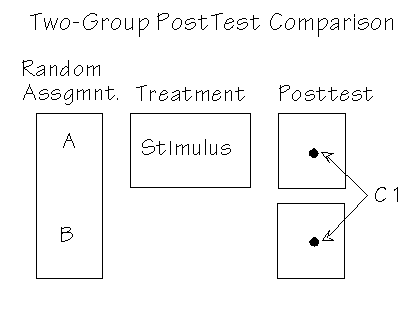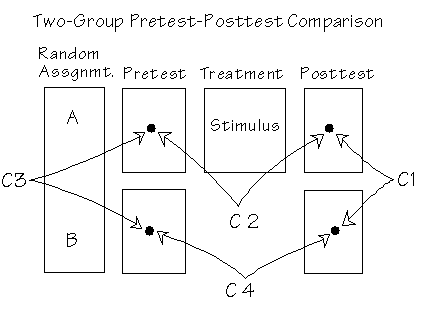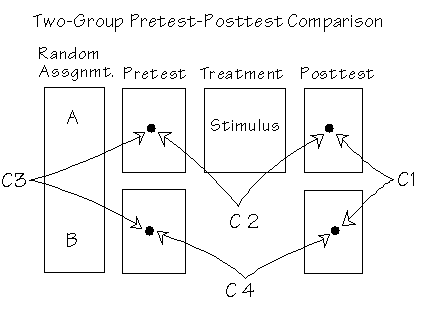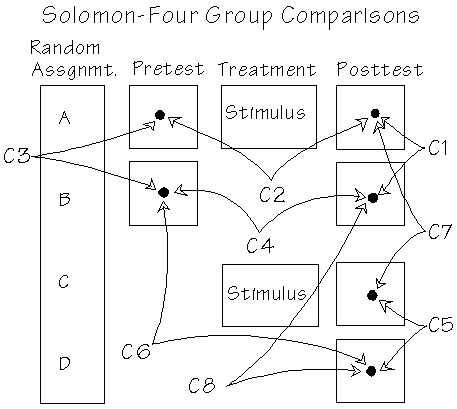
1. Under what conditions is experimental research most appropriate?
Experiments begin with random assignment to conditions, which produces equivalent groups. One group is subjected to the changed conditions and the other isn't. The other two necessary components of experiments are isolation and manipulation of an independent variable (causal factor), and subsequent measurement of a dependent variable (the effect).
While this strategy may produce less natural or "realistic" results than those produced by other research approaches, it can be used to identify causal relationship, something that is at best difficult to do with other methods. If you want to identify causal relationships, your first choice of research approaches would be the experimental method.
2. What can you do with experiments that you cannot do with other approaches to research?
Experiments can be used to identify causal relationship, something that is difficult or impossible to do with other methods.
3. Why are control groups used in experiments? What do they do for you?
The logic of the experimental method is to begin with two identical or equivalent groups of individuals and to do something to the members of one group. Since the groups were the same to begin with, any differences you see between the groups afterwards must be due to whatever it was that you did to the members of one of the groups. The experiment is the most highly controlled of the research designs. An important source of this control comes from the way experiments are set up, with various groups being subjected to different conditions. The division of subjects into conditions allows a number of comparisons to be drawn, each of which gives the researcher information about a facet of the research situation, such as the experimental stimulus, the pre-test, or the passage of time. For each factor you want to assess, you would have one group that is subjected to the factor and one that is not. The groups that are not subjected to the various factors are control groups.
4. Why is random assignment to groups used in experiments? What does it do for you?
In order to determine what effect something has on people, you subject some people to that "something" and then you compare them with people who were not subjected to the "something." If you know that the groups of people were the same to begin with, you can assume that any differences you see between them afterwards must be due to the one way in which they differ, which is whether or not they were subjected to the "something."
In the same way that random selection makes your sample representative and eliminates bias, randomly assigning subjects to conditions automatically matches the. Random assignment controls for all possible kinds of differences between people.
Random assignment to conditions gives you groups that do not differ from one another in any systematic way.
5. What are the main strengths and weaknesses of experiments?
Strengths: The experimental method makes it possible to determine whether changes in the independent variable cause subsequent changes in the dependent variable. While other types of research make it possible to determine whether or not there is a correlation between a pair of variables, only the experiment can tell whether there is a causal relationship. Experiments, by their very nature, require a particular sequence of events to take place in a particular temporal order. They focus on change over time, while survey methods are much better at identifying static correlational patterns.
Weaknesses: The main weakness of the experimental method is their dependence on what many see as an "artificial" environment. People may behave differently in the experimental setting than they would under more ordinary conditions. While the artificial environment of the experiment allows the unpredictable complexities of ordinary life to be "controlled," it tends to remove the participants from the ordinary context in which they live and place them instead in an artificial environment that has little or no resemblance to the "real world."
Researchers generally want to see changes in their dependent variables. They want to see differences between their experimental and control groups. Because of this, the apparent changes seen in the dependent variable may be caused by the experimenter's subtle cues and not by the independent variable.
Due to the costs involved or the structure of the experimental situation, it is often difficult to obtain experimental samples large enough to obtain results that are stable enough to allow generalizations to larger populations.
Experimental methods require the researcher to identify and control all relevant variables that might distort the apparent relation between independent and dependent variables. In the natural sciences where all the complexities of the social world do not have to be considered, this may be accomplished. But in the social sciences where the subject of inquiry is a social situation that takes place in a social context, it may not be possible to identify all relevant variables or potential "disturbances." This is one of the reasons that very few social experiments are considered conclusive.
6. Compare the two-group pretest-posttest design to the two-group posttest only design. What additional information does the pretest give you in the former? What potential sources of invalidity does the pretest allow you to rule out?


Diagrams for the two-group pretest-posttest design and the two-group posttest only design are shown above.
You can see that three additional comparisons of groups are possible with the pretest-posttest design; three comparisons that are not possible with the posttest-only design. Having pretest measures allows you to determine whether or not the random assignment produced two equivalent groups (Comparison 3). Comparisons 2 and 4 show how the two groups changed over the time spanned by the experiment. With the pretest-only design, you don't have any measures of change at all. You can only assume that any difference you see in the one comparison that is possible is due to the stimulus and not to other factors.
With the pretest-posttest design, you can look at comparison 4 to see if there is any difference over time for the control group. If there is a difference here, it is not due to the experimental stimulus, since the members of this group do not receive the stimulus. Therefore, if you see a difference in this comparison, you should be concerned about what is causing it and what effect it will have on the experimental group as well.
7. Compare the Solomon four-group design to the two-group pretest-posttest design. What additional information do the additional groups give you in the former? What potential sources of invalidity do they allow you to rule out?


The Solomon four group design adds two more control groups. The posttest of Group C is compared to the posttest of Group A in comparison 7 to see what effect the pretest has in combination with the stimulus. If the posttest measures of Groups A and C differ, you know the pretest either influences the posttest directly or it influences the effect of the stimulus. In either case, you will be concerned.
The posttest of Group C is also compared to the posttest of Group D in comparison 5. You should see the same difference here as you see with comparison 1 for Groups A and B. If the C-D difference is not the same as the A-B difference, you know the pretest is having an influence; it is probably interacting with the stimulus.
Group D is used in comparison 8 to test the effect of the pretest. You hope this comparison shows that there is little or no difference between the posttests of Groups B and D. If there is a difference, you will suspect the pretest has an influence on the posttest and that the time between the pretest and the posttest for Group B is having an effect on the posttest.
Group D is also used in comparison 6 to determine whether external events have acted as another stimulus and influenced the measurement of Group D. Examples would be if the pretests were all given in the early afternoon and the posttests in the evening or if the pretest and posttest are separated by a longer period of time (weeks, months) and some political event has altered the way people feel or think about events or ideas related to the issue your study is investigating.
8. How can you determine whether the pretest is influencing the way people respond to the experimental stimulus?
Comparison 7 in the Solomon four group design shown in the answer for Question 6 does this.
9. How can you determine whether the pretest is influencing the way people respond to the posttest?
Comparisons 7 and 8 in the Solomon four group design shown in the answer for Question 6 does this.
10. How can you check the validity of the random assignment to conditions?
Comparison 3 in the two-group pretest-posttest design and in the Solomon four group design does this. Both of these comparisons look at two pretest measurements taken at one point in time. If the pretest shows that groups are different, you know that there is a problem with the random assignment procedure.